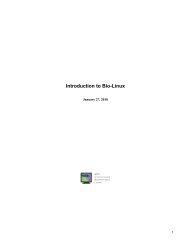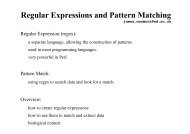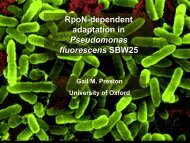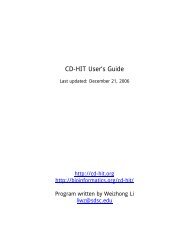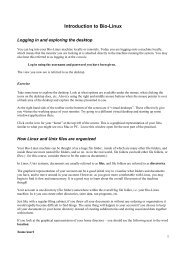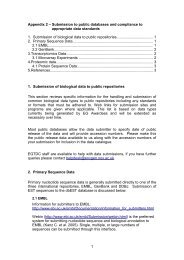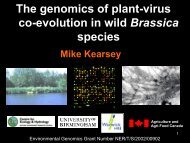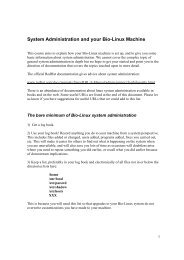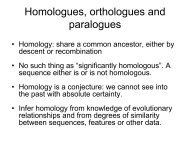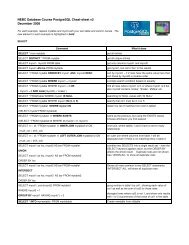User Manual for Dendroscope V1.4
User Manual for Dendroscope V1.4
User Manual for Dendroscope V1.4
You also want an ePaper? Increase the reach of your titles
YUMPU automatically turns print PDFs into web optimized ePapers that Google loves.
Contents<br />
<strong>User</strong> <strong>Manual</strong> <strong>for</strong> <strong>Dendroscope</strong> <strong>V1.4</strong><br />
Daniel H. Huson, Daniel C. Richter, Christian Rausch and Regula Rupp<br />
July 4, 2008<br />
Contents 1<br />
1 Introduction 2<br />
2 Program Overview 3<br />
3 Obtaining and Installing the Program 3<br />
4 Getting Started 4<br />
5 Main Window 4<br />
5.1 File Menu . . . . . . . . . . . . . . . . . . . . . . . . . . . . . . . . . . . . . . . . . . 4<br />
5.2 Edit Menu . . . . . . . . . . . . . . . . . . . . . . . . . . . . . . . . . . . . . . . . . . 5<br />
5.3 Select Menu . . . . . . . . . . . . . . . . . . . . . . . . . . . . . . . . . . . . . . . . . 6<br />
5.4 Options Menu . . . . . . . . . . . . . . . . . . . . . . . . . . . . . . . . . . . . . . . . 6<br />
5.5 Tree Menu . . . . . . . . . . . . . . . . . . . . . . . . . . . . . . . . . . . . . . . . . . 7<br />
5.6 View Menu . . . . . . . . . . . . . . . . . . . . . . . . . . . . . . . . . . . . . . . . . 7<br />
1
5.7 Window Menu . . . . . . . . . . . . . . . . . . . . . . . . . . . . . . . . . . . . . . . 8<br />
5.8 Toolbar . . . . . . . . . . . . . . . . . . . . . . . . . . . . . . . . . . . . . . . . . . . 9<br />
5.9 Context Menus . . . . . . . . . . . . . . . . . . . . . . . . . . . . . . . . . . . . . . . 9<br />
5.10 Sidebar . . . . . . . . . . . . . . . . . . . . . . . . . . . . . . . . . . . . . . . . . . . 9<br />
5.11 Statusbar . . . . . . . . . . . . . . . . . . . . . . . . . . . . . . . . . . . . . . . . . . 10<br />
6 Additional Windows 10<br />
6.1 Format Panel . . . . . . . . . . . . . . . . . . . . . . . . . . . . . . . . . . . . . . . . 10<br />
6.2 Find Window . . . . . . . . . . . . . . . . . . . . . . . . . . . . . . . . . . . . . . . . 10<br />
6.3 Message Window . . . . . . . . . . . . . . . . . . . . . . . . . . . . . . . . . . . . . . 11<br />
6.4 Export Image Dialog . . . . . . . . . . . . . . . . . . . . . . . . . . . . . . . . . . . . 11<br />
6.5 About Window . . . . . . . . . . . . . . . . . . . . . . . . . . . . . . . . . . . . . . . 12<br />
7 Additional Features 12<br />
7.1 Using the Mouse to Select . . . . . . . . . . . . . . . . . . . . . . . . . . . . . . . . . 12<br />
7.2 Magnifier Functionality . . . . . . . . . . . . . . . . . . . . . . . . . . . . . . . . . . 12<br />
7.3 Navigating trees with keys and mouse wheel . . . . . . . . . . . . . . . . . . . . . . . 12<br />
8 File Formats 13<br />
8.1 <strong>Dendroscope</strong> Files . . . . . . . . . . . . . . . . . . . . . . . . . . . . . . . . . . . . . 13<br />
8.2 Nexus files . . . . . . . . . . . . . . . . . . . . . . . . . . . . . . . . . . . . . . . . . . 13<br />
8.3 Newick files . . . . . . . . . . . . . . . . . . . . . . . . . . . . . . . . . . . . . . . . . 13<br />
8.4 Graphics Formats . . . . . . . . . . . . . . . . . . . . . . . . . . . . . . . . . . . . . . 13<br />
9 Commands 14<br />
10 Examples 15<br />
11 Acknowledgements 15<br />
References 16<br />
Index 19<br />
1 Introduction<br />
Disclaimer: This software is provided ”AS IS” without warranty of any kind. This is develop-<br />
2
mental code, and we make no pretension as to it being bug-free and totally reliable. Use at your<br />
own risk. We will accept no liability <strong>for</strong> any damages incurred through the use of this software.<br />
Use of the <strong>Dendroscope</strong> is free, however the program is not open source.<br />
Type-setting conventions: In this manual we use e.g. Edit→Find to indicate the Find menu<br />
item in the Edit menu.<br />
How to cite: If you publish results obtained in part by using <strong>Dendroscope</strong> , then we require that<br />
you acknowledge this by citing the program as follows:<br />
• Daniel H Huson, Daniel C Richter, Christian Rausch, Tobias Dezulian, Markus Franz and<br />
Regula Rupp. <strong>Dendroscope</strong>: An interactive viewer <strong>for</strong> large phylogenetic trees . BMC Bioin<strong>for</strong>matics<br />
8:460, 2007, software freely available from www.dendroscope.org [2].<br />
2 Program Overview<br />
<strong>Dendroscope</strong> is a plat<strong>for</strong>m-independent software written in Java that enables conveniently to browse<br />
phylogenetic trees with up to hundreds of thousands of taxa. Here is an overview of its features:<br />
• There are 8 different tree views available, e.g. phylogram, cladogram or radial views.<br />
• Its novel navigational features facilitate the analysis of large trees.<br />
• It provides several tree manipulating functions like rerooting, subtree rotating, tree flipping<br />
and <strong>for</strong>mating features like renaming, coloring or resizing edges, nodes and labels.<br />
• A comprehensive set of export <strong>for</strong>mats <strong>for</strong> the generation of images is available.<br />
• <strong>User</strong> <strong>for</strong>mated trees can be saved as a <strong>Dendroscope</strong> project file or as .nexus, or Newick tree<br />
files.<br />
• Tree structures (single or multiple) can be loaded from .tre (Newick <strong>for</strong>mat) or .nexus files<br />
or entered manually.<br />
3 Obtaining and Installing the Program<br />
<strong>Dendroscope</strong> is written in Java and requires a Java runtime environment version 1.4 or newer, freely<br />
available from www.java.org.<br />
<strong>Dendroscope</strong> is installed using an installer program that is freely available from<br />
www.dendroscope.org. There are three different installers, targeting different operating systems:<br />
• <strong>Dendroscope</strong> windows 1.4.exe provides an installer <strong>for</strong> Windows.<br />
• <strong>Dendroscope</strong> macos 1.4.dmg provides an installer <strong>for</strong> MacOS.<br />
• <strong>Dendroscope</strong> unix 1.4.sh provides a shell installer <strong>for</strong> Linux and Unix.<br />
3
Alternatively <strong>Dendroscope</strong> will be available as Java Webstart application from<br />
www-ab2.in<strong>for</strong>matik.uni-tuebingen.de/webstart/dendroscope. If you need in<strong>for</strong>mation concerning<br />
Java Webstart, go to http://java.sun.com/products/javawebstart/.<br />
4 Getting Started<br />
This section describes how to get started and to do the first steps of analyses using <strong>Dendroscope</strong> .<br />
First, download an installer <strong>for</strong> the program from<br />
www.dendroscope.org, see Section 3 <strong>for</strong> details.<br />
Start the program and load any .tre, .nexus or .dendro project file via File→Open . Alternatively,<br />
if the file was recently opened by the program, then it may be contained in the File→Recent<br />
Files submenu.<br />
At startup, the tree will be scaled to fit to the window size.<br />
Draw the tree differently by choosing one of the 8 provided views e.g. Tree→Draw Rectangular<br />
Phylogram , Tree→Draw Rectangular Cladogram , Tree→Draw Slanted Cladogram ,<br />
Tree→Draw Circular Phylogram , Tree→Draw Circular Cladogram , Tree→Draw Internal<br />
Circular Cladogram , Tree→Draw Radial Phylogram , Tree→Draw Radial Cladogram . Try<br />
out the magnifier functions by clicking on View→Use Magnifier . Change any label font, size,<br />
color or edge/node size/width by opening the Format Panel via Edit→Format .<br />
If you want to print the current image choose File→Print . In case you need a quality image of<br />
the tree, simply export it to several file <strong>for</strong>mats via File→Export Image .<br />
Finally, if you want to save the tree(s) and the <strong>for</strong>matting click File→Save As generating a<br />
.dendro project file. You can alos export the tree(s) by clicking File→Export . Choose one of the<br />
export <strong>for</strong>mats (newick, nexus, dendro).<br />
Note that only by saving a <strong>for</strong>matted tree as a .dendro project file you can save the <strong>for</strong>matting<br />
with the tree.<br />
5 Main Window<br />
The Main window is used to display the taxonomy and to control the program via the main<br />
menus.<br />
We now discuss all menus of the Main window.<br />
5.1 File Menu<br />
The File menu contains the following file-related items:<br />
• The File→New item opens an empty <strong>Dendroscope</strong> document.<br />
• The File→Open item provides an Open File dialog to open one or more <strong>Dendroscope</strong><br />
files (see Section 8) or .tre or .nexus files containing input data.<br />
4
• The File→Recent Files item can be used to re-open a recently opened file.<br />
• The File→Save item can be used to save the current tree and layout as <strong>Dendroscope</strong><br />
project file.<br />
• The File→Save As item can be used to save the current tree(s) as <strong>Dendroscope</strong> project<br />
file (.dendro) with the topology and layout.<br />
• The File→Export item can be used to export the current tree(s) to Newick or Nexus file<br />
<strong>for</strong>mat. Note that only the topology but not the layout will be saved.<br />
• The File→Duplicate item opens an additional window of <strong>Dendroscope</strong> containing the<br />
current tree.<br />
• The File→Export Image item opens the Export Image dialog which is used to save the<br />
current tree in a number of different graphics <strong>for</strong>mats, see Section 8.4.<br />
• The File→Print item is used to print the current tree.<br />
• The File→Close item closes the current window. In case only one window is opened,<br />
the application exits.<br />
• The File→Quit item quits the program. Under MacOS , this item is contained in the<br />
<strong>Dendroscope</strong> menu.<br />
5.2 Edit Menu<br />
The Edit menu contains the usual edit-related items:<br />
• The Edit→Copy Image to Clipboard item is used to copy the current tree as an image<br />
which can be directly pasted into any picture editing software.<br />
• The Edit→Find item opens the Find window which can be used to search <strong>for</strong> taxa and<br />
labels.<br />
• The Edit→Find Again item finds the next occurrence of a search string.<br />
• The Edit→Reroot item reroots the tree at the specified node or edge. If more than<br />
node is selected, all selected taxon labels are intepreted as outgroup taxa and the program<br />
determines the “tightest” rooting so that the outgroup appear together below the root.<br />
• The Edit→Swap Subtree item swaps the subtree at the specified node, see also Section<br />
7.3<br />
• The Edit→Rotate Subtree item rotates the subtree at the specified node.<br />
• The Edit→Reorder Subtree item opens a dialog that allows one to specific any type of<br />
reordering of the children of a node using “drag and drop”.<br />
• The Edit→Delete Taxa item removes the selected subtree <strong>for</strong>m the current tree.<br />
5
• The Allow Reshape→i tem is used to set the “allow reshape” mode in which the user is<br />
allowed to move individual nodes and internal edge points.<br />
• The Edit→Format item opens a Format Panel which provides several possibilities to<br />
change color, fonts, node and edge shapes and the positioning of the labels of the tree.<br />
5.3 Select Menu<br />
The Select menu contains items <strong>for</strong> selecting different sets of substructures of the tree.<br />
• The Select→Select All item is used to select all nodes, edges and labels.<br />
• The Select→Select Nodes item is used to select all nodes.<br />
• The Select→Select Edges item is used to select all edges.<br />
• The Select→Deselect All item is used to deselect all nodes, edges and labels that are<br />
currently selected.<br />
• The Select→Deselect Nodes item is used to deselect all nodes that are currently<br />
selected.<br />
• The Select→Deselect Edges item is used to deselect all edges that are currently selected.<br />
• The Select→Select Leaves item is used to select all leaves with their labels.<br />
• The Select→Select Subtree item is used to select a subtree of a selected inner node.<br />
• The Select→Select Root item is used to select the root node of the tree.<br />
• The Select→Select Non-Terminal item is used to select all non-terminal nodes and<br />
edges.<br />
• The Select→Invert Selection item is used to invert the current selection.<br />
• The Select→Scroll to Selection item is used to scroll to the current selection.<br />
• The Select→List Selected Taxa item is used to list all selected taxa.<br />
5.4 Options Menu<br />
The Options menu contains items <strong>for</strong> collapsing nodes and extracting subtrees.<br />
• The Option→Collapse item enables to collapse a subtree at a selected specified node.<br />
The <strong>for</strong>mer subtree is replaced by a new ”edge” with label [...].<br />
• The Option→Uncollapse item is used to uncollapse (expand) a selected, collapsed subtree.<br />
• The Option→Collapse Complement item is used to collapse all subtrees except the<br />
currently selected part of the tree.<br />
6
• The Option→Collapse at Level item is used to collapse all subtrees at the specified<br />
level from the root.<br />
• The Option→Extract Subtree item is used to extract a selected subtree to a new file.<br />
5.5 Tree Menu<br />
The Tree menu contains items <strong>for</strong> different tree views.<br />
• The Tree→Draw Rectangular Phylogram item is used to draw the tree as rectangular<br />
phylogram.<br />
• The Tree→Draw Rectangular Cladogram item is used to draw the tree as rectangular<br />
cladogram.<br />
• The Tree→Draw Slanted Cladogram item is used to draw the tree as slanted cladogram.<br />
• The Tree→Draw Circular Phylogram item is used to draw the tree as circular phylogram.<br />
• The Tree→Draw Circular Cladogram item is used to draw the tree as circular cladogram.<br />
• The Tree→Draw Internal Circular Cladogram item is used to draw the tree as circular<br />
cladogram with leaves on the inside.<br />
• The Tree→Draw Radial Phylogram item is used to draw the tree as radial phylogram.<br />
• The Tree→Draw Radial Cladogram item is used to draw the tree as radial cladogram.<br />
• The Tree→Previous Tree item is used to switch to the last opened tree.<br />
• The Tree→Next Tree item is used to switch to the next opened tree.<br />
• The Tree→Ladderize Left item is used to order the tree so that the largest clades<br />
appear leftmost (uppermost in the view).<br />
• The Tree→Ladderize Right item is used to order the tree so that the largest clades<br />
appear rightmost (lowermost in the view).<br />
• The Tree→Ladderize Random item is used to order the clades randomly.<br />
5.6 View Menu<br />
The Views menu contains items <strong>for</strong> scaling the tree, using the magnifier and showing/hiding<br />
labels.<br />
• The View→Zoom to Fit item is used to scale the tree to fit the window.<br />
• The View→Fully Contract item is used to contract the tree.<br />
• The View→Fully Expand item is used to expand the whole tree.<br />
7
• The View→Use Magnifier item is used to turn the magnifier functionality on and off.<br />
• The View→Magnify All Mode item modifiers the magnification process so that the whole<br />
tree gets mapped into the magnifier.<br />
• The View→Show Node Labels item is used to make all node labels visible.<br />
• The View→Hide Node Labels item is used to hide all node labels.<br />
• The View→Show Edge Weights item is used to make edge weights visible.<br />
• The View→Show Edge Labels item is used to make edge labels visible.<br />
• The View→Hide Edge Labels item is used to hide edge labels.<br />
• The View→Sparse Labels item instructs the program to show only a subset of the taxon<br />
labels, thus avoiding overlapping labels.<br />
• The View→Radial Labels item instructs the program to rotate leaf labels to match the<br />
orientation of the edges that lead to them.<br />
• The View→Reposition Labels item sets all the labels to their original position.<br />
5.7 Window Menu<br />
The Window menu contains a number of window-related commands as well as a list of all currently<br />
open windows.<br />
• The Window→About item opens a splash screen showing the program version. In MacOS,<br />
this can be found under <strong>Dendroscope</strong>→About .<br />
• The Window→How to Cite item shows the citation info <strong>for</strong> this software which is:<br />
Daniel H Huson, Daniel C Richter, Christian Rausch, Tobias Dezulian, Markus Franz and<br />
Regula Rupp. <strong>Dendroscope</strong>: An interactive viewer <strong>for</strong> large phylogenetic trees . BMC Bioin<strong>for</strong>matics<br />
8:460, 2007.<br />
• The Window→Set Window Size item is used to set the size of the Main window.<br />
• The Window→Command syntax item lists all commands supported by the program.<br />
• The Window→Execute Command item opens a window that can be used to enter a command<br />
(see command).<br />
• The Window→Enter Tree item opens a window to enter a tree manually in Newick<br />
Format.<br />
• If several program windows are openend, they are listed at the end of the window menu.<br />
• The Window→Message Window item is used to open the Message window.<br />
8
5.8 Toolbar<br />
For easier access of frequently used functions, a Toolbar is provided with the following functions:<br />
• File→Open , File→Save As , File→Print , File→Export Image , Edit→Format<br />
• The Expand view vertically button expands the tree vertically.<br />
• The Contract view vertically button shrinks the tree vertically.<br />
• The Expand view horizontally button expands the tree horizontally.<br />
• The Contract view horizontally button shrinks the tree horizontally.<br />
• The Rotate Left button rotates the whole tree to the left.<br />
• The Rotate Right button rotates the whole tree to the right.<br />
• View→Zoom to Fit , View→Fully Contract , View→Fully Expand , View→Use<br />
Magnifier , Tree→Draw Rectangular Phylogram , Tree→Draw Rectangular Cladogram<br />
, Tree→Draw Slanted Cladogram , Tree→Draw Circular Phylogram , Tree→Draw<br />
Circular Cladogram , Tree→Draw Internal Circular Cladogram , Tree→Draw Radial<br />
Phylogram , Tree→Draw Radial Cladogram , Edit→Find , Tree→Ladderize Left<br />
, Tree→Ladderize Right , Tree→Ladderize Random Tree→Ladderize Random<br />
Edit→Reroot Edit→Swap Subtree<br />
5.9 Context Menus<br />
A right mouse click on a node opens a context menu which allows to edit the node label, open the<br />
Format Panel, show or hide node labels, copy the node label, select the subtree starting from this<br />
node, and swap the subtree starting from this node.<br />
A right mouse click on an edge opens a context menu which allows to edit the edge label, open the<br />
Format Panel, show or hide edge labels, and copy the edge label.<br />
A right mouse click beside the tree opens a context menu which allows to select or deselect all<br />
edges, nodes, and labels.<br />
5.10 Sidebar<br />
The Sidebar on the left contains a list of all trees in the current file. The arrows on top can be<br />
used to browse the list. Additionally, one can change the order of the list by dragging and dropping<br />
single trees to a new position in the list. The sidebar can be made (in)visible when clicking the<br />
small (left) right arrow located on the sidebar itself.<br />
Right-clicking on one of the trees listed in the sidebar opens a popup menu with the following items:<br />
• The Rename item can be used to rename a tree.<br />
• The Duplicate item can be used to duplicate a tree.<br />
9
• The Clear Formatting item can be used to clear all <strong>for</strong>mating of a tree (such as choice<br />
of colors and fonts, etc.).<br />
• The Remove item can be used to remove a tree <strong>for</strong> the list of trees.<br />
5.11 Statusbar<br />
The Statusbar at the bottom of the program window shows the index of the current tree,<br />
the total number of trees, the number of nodes and edges and the available space of the reserved<br />
memory.<br />
6 Additional Windows<br />
6.1 Format Panel<br />
The Format Panel can be opened via Edit→Format or by a right mouse click after selecting<br />
elements of the tree like edges, nodes or labels. You can <strong>for</strong>mat them as follows:<br />
• Edges can have their edge width and edge width set.<br />
• Edges can be assigned three types of shapes: straight edges, curved edges and angular edges,<br />
the effect of which depends on the current view.<br />
• Nodes can be assigned certain shapes: square nodes, circle nodes or none. Square and circle<br />
node shapes. They can have their node size and node color set.<br />
• If a selected node or edge has a label, then you can choose its font family, font style or font<br />
size.<br />
• Labels can be switched on and off, and can be rotated to the left or right. .<br />
Configuration changes are applied immediately. The Options→Save Font As Default menu<br />
item can be used to set the default font, style and size used by the program. .<br />
6.2 Find Window<br />
The Find window can be opened using the Edit→Find item. Its purpose is to find taxa in the<br />
tree. Enter a query specifying the name of a taxon in the top text region. Use the following check<br />
boxes to configure the search:<br />
• If the Match Whole item is selected, then only taxa or labels matching the complete query<br />
string will be returned.<br />
• If the Respect Case item is selected, then the case of letters is distinguished in comparisons.<br />
10
• If the Regular Expression item is selected, the query is interpreted as a Java regular<br />
expression (see example further down).<br />
If a searched label is ”hidden” inside a bounding box (black opaque area of tree) or in a collapsed<br />
branch, it will be highlighted.<br />
Press the Close, Find First, Find Next or Find All buttons to close the dialog, or find the first,<br />
or next occurrence of the query, respectively.<br />
Alternatively, use the From File button to find all nodes that match any line of a given input<br />
file. The Match Whole, Respect Case and Regular Expression buttons apply to this type of<br />
search, too.<br />
Regular Expressions are powerful and flexible text-processing tools. They allow to specify<br />
complex patterns of text that can be discovered in an input string.<br />
Example:<br />
Each of the following represent valid regular expressions, and all will successfully match the character<br />
sequence ”Escherichia”:<br />
• Escherichia<br />
• E.*<br />
• [eE]scherichia<br />
• [eE]sch[aeiou][a-z]ichi.*<br />
For an extensive list of metacharacters and futher explanations go to<br />
http://java.sun.com/j2se/1.5.0/docs/api/java/util/regex/Pattern.html<br />
6.3 Message Window<br />
The Message window is opened using the Window→Message Window item. The program writes<br />
all internal messages to this window. The window contains the usual File and Edit menu items.<br />
6.4 Export Image Dialog<br />
The Export Image dialog is opened using the File→Export Image item. This dialog is used<br />
to save an image of the current tree in a number of different <strong>for</strong>mats, see Section 8.4.<br />
The <strong>for</strong>mat is chosen from a menu. There are two radio buttons Save whole image to save the<br />
whole image, and Save visible region to save only the part of the image that is currently<br />
visible in the main viewer. If the chosen <strong>for</strong>mat is EPS , then selecting the Convert text to<br />
graphics check box will request the program to render all text as graphics, rather than fonts.<br />
Pressing the apply button will open a standard file save dialog to determine where to save the<br />
graphics file.<br />
11
6.5 About Window<br />
The About Window is opened using the Window→About submenu ( <strong>Dendroscope</strong>→About in<br />
MacOS). It reports the version of the program and its authors.<br />
7 Additional Features<br />
7.1 Using the Mouse to Select<br />
Nodes, edges and labels can also be selected by clicking on them , shift-clicking to extend a selection<br />
or by shift-clicking and then dragging the mouse to per<strong>for</strong>m rubber-band selection in which all<br />
objects contained within a dragged rectangle are selected.<br />
Note Unlike many programs, where rubber-band selection is per<strong>for</strong>med by click-dragging, <strong>Dendroscope</strong><br />
requires that you shift-click and drag.<br />
7.2 Magnifier Functionality<br />
<strong>Dendroscope</strong> provides the user with a magnifier functionality that can be used to magnify<br />
portions of the tree.<br />
Selecting the View→Use Magnifier item adds a magnifier layer to the view.<br />
• Magnifier band: For all rooted views (rectangular and slanted view) a magnifier band is<br />
laid over the tree.<br />
• Magnifier disk: For all unrooted views (radial and circular tree view) a circular magnifier<br />
is laid over the tree.<br />
The magnifier can be pulled to a desired position by grabbing its frame with the mouse. The<br />
radius/width of the magnifier can be changed by dragging the rhomb at the magnifier’s border line.<br />
The zoom factor of the magnifier can be changed via the [+,-] button.<br />
Two magnifier modes are available depending on the current tree view:<br />
7.3 Navigating trees with keys and mouse wheel<br />
<strong>Dendroscope</strong> allows one to browse and analyze trees. Navigating trees is facilitated by some<br />
key bindings :<br />
• Scrolling: Hold down the Shift button and use the mouse wheel to scroll top-down.<br />
Hold down the Alt and Shift buttons and use the mouse wheel to scroll right-left.<br />
• Zooming: Use the mouse wheel to zoom the tree. Zooming is centered on the current mouse<br />
position. Alternatively, use the ↑ and ↓ arrow keys to zoom. Additionally, press the the Shift<br />
key <strong>for</strong> acceleration.<br />
12
• Rotating: Hold down the Alt button and use the mouse wheel to rotate the tree. Alternatively,<br />
use the ← and the → arrow keys to rotate. Additionally, press the the Shift key <strong>for</strong><br />
acceleration.<br />
8 File Formats<br />
<strong>Dendroscope</strong> uses its own file <strong>for</strong>mat to store the data of the modified and/or <strong>for</strong>matted tree. By<br />
convention, we use the suffix .dendro <strong>for</strong> <strong>Dendroscope</strong> files.<br />
8.1 <strong>Dendroscope</strong> Files<br />
<strong>Dendroscope</strong> saves trees in a simple text-based <strong>for</strong>mat with the file extension .dendro. It contains<br />
the tree in Newick notation and additional (machine-readable) in<strong>for</strong>mation on the view, selections,<br />
coloring etc. of the saved trees.<br />
Trees can also be saved in Nexus and Newick <strong>for</strong>mat. However, when these <strong>for</strong>mats are used, all<br />
in<strong>for</strong>mation on the layout of the trees, fonts, colors, linewidths etc are lost.<br />
8.2 Nexus files<br />
<strong>Dendroscope</strong> can read a Nexus file that contains a Nexus trees block and can export trees in this<br />
<strong>for</strong>mat.<br />
8.3 Newick files<br />
<strong>Dendroscope</strong> can read Newick files and can export trees in this <strong>for</strong>mat.<br />
8.4 Graphics Formats<br />
The following graphics <strong>for</strong>mats are supported (how to open the Export Image dialog see 6.4):<br />
• JPEG, “Joint Photographic Experts Group”.<br />
• GIF, “Graphics Interchange Format”.<br />
• EPS, “Encapsulated PostScript”.<br />
• SVG, “Scalable Vector Graphics”.<br />
• PNG, “Portable Network Graphics”.<br />
• BMP, “Bitmap”.<br />
• PDF, “Portable Document Format”.<br />
13
9 Commands<br />
The program provides a command-intepreter to access all its functionalities. a command can be<br />
entered either using the Window→Enter Command item or by starting the program in command-line<br />
mode and typing (or piping) commands to the program via the console.<br />
The Command window has a field <strong>for</strong> entering commands, a cancel button and two two different<br />
apply buttons. The Apply button applies the entered command to the current tree, whereas the<br />
Apply to All button applies the entered command to all trees in the current file.<br />
Here is a summary of all available commands:<br />
Opening and saving files:<br />
open file=name [init=command] - Open the named file in the current window, if empty, otherwise in a new window<br />
optionally per<strong>for</strong>m specified initial commands in new window<br />
launch file=name - Open the named file in the current window<br />
save [<strong>for</strong>mat=value] file=name - Save data to file in the specified <strong>for</strong>mat (possible <strong>for</strong>mats: nexus newick dendro)<br />
exportgraphics [<strong>for</strong>mat={EPS|PNG|GIF|JPG|SVG|PDF}] [replace=bool] [textasshapes=bool] [title=title] file=filename -<br />
Export a picture of the current tree<br />
source file=name - Read commands from the named file<br />
Choosing tree and visualization:<br />
set which=value - Sets the current tree (possible values: number-of-tree first last previous next)<br />
set drawer=drawer-name - Set the drawer used to draw the tree<br />
(Possible values: RectangularPhylogram RectangularCladogram SlantedCladogram<br />
RadialPhylogram RadialCladogram CircularPhylogram CircularCladogram InnerCircularCladogram)<br />
set auxilaryparameter=number - Set the auxilary parameter used by some of the drawers<br />
Customizing the layout of a tree:<br />
reroot - Reroot current tree using currently selected set of nodes (outgroups), node or edge<br />
ladderize=value - Ladderize each displayed tree (possible values: left right random none)<br />
rotatesubtree - Rotate all children of all selected nodes<br />
swapsubtree - Swap subtree below selected node(s)<br />
reset labelpositions - Reset all node label positions<br />
center - Center the tree<br />
rotate angle=number - Rotate the whole tree by the given angle (in radian)<br />
set hflip=bool - Flip the tree horizontally?<br />
rotatelabels - Rotate the labels of selected nodes<br />
Adding, creating and modifying trees:<br />
add tree=newick-tree - Add the specified tree to the list of trees<br />
duplicate - Duplicate the current window<br />
extractsubtree - Extract the subtree induced by the currently selected nodes<br />
extractlsatree - Extract the LSA-tree from a rooted network<br />
remove taxa={selected| names} - Remove all selected taxa, if taxa=selected, otherwise, remove named taxa<br />
compute consensus=value Compute a consensus tree or network of a set of trees<br />
(possible values: Strict Majority Loose Network LSA)<br />
remove innerlabels - Remove all labels of inner nodes<br />
apply command - Applies the given command to all trees in the file<br />
Selection and Deselection:<br />
select all - Select all nodes and edges<br />
select nodes - Select all nodes<br />
select edges - Select all edges<br />
select previous - Select all labeled nodes as in previous window<br />
select leaves - Select all leaves<br />
select subtree - Select all nodes in subtrees below selected<br />
select subpart - Select part of subtree<br />
select nonterminal - Select all non-terminal nodes<br />
select intermediate - Select all intermediate nodes<br />
select root - Select root<br />
select special - Select all ’special’ edges<br />
select invert - Invert the current selection<br />
deselect all - Deselect all nodes and edges<br />
deselect nodes - Deselect all nodes<br />
deselect edges - Deselect all edges<br />
list taxa=selected - List all currently selected taxa<br />
Searching:<br />
find pattern - Find and select the next taxon matching the given pattern (Java regular expression)<br />
findall pattern Find and select all taxa matching the given pattern<br />
find file - Find and select all taxa matching a line in the given file<br />
Collapsing and uncollapsing nodes:<br />
collapse all - Collapse all nodes<br />
collapse selection - Collapse all selected nodes<br />
collapse complement - Collapse the complement of all selected nodes<br />
collapse level=number - Collapse all nodes at the given level (distance from root)<br />
uncollapse all - Uncollapse all nodes<br />
14
uncollapse selection - Uncollapse all selected nodes<br />
uncollapse subtree - Uncollapse whole subtree <strong>for</strong> selected nodes<br />
Visualization:<br />
set window [width=num] [height=num] [x=num] [y=num]-<br />
Set size and location of main window<br />
set font=name Set font by name<br />
set autolayoutlabels=bool - Set auto-layout of labels<br />
set margin [left=num] [right=num] [top=num] [bottom=num] -<br />
Set the margin around the tree<br />
show edgelabels=bool - Show or hide edge lbels<br />
show edgeweights=bool - Show or hide edge weights<br />
show nodelabels=bool - Show or hide node labels<br />
show intermediatenodelabels=bool -<br />
Show or hide labels of intermediate nodes<br />
set maintainedgelengths=bool - When set, edge lengths cannot be changed, when not set, edges can be stretched<br />
set eshape=value - Set the shape of selected edges (possible values: polygon quadratic cubic)<br />
set nshape=value - Set the shape of selected nodes (possible values: rect oval)<br />
set radiallabels=bool - Set radial layout of node labels<br />
set sparselabels=bool - Set sparse layout of node labels (in which labels that would overlap others are not shown)<br />
set color=color - Set the color of all selected nodes and edges<br />
set bgcolor=color - Set the background color of all selected nodes<br />
set labelcolor=color - Set the label color of all selected nodes and edges<br />
set edgewidth=number - Set the line width of all selected edges<br />
set nodesize=number - Set the size of all selected edges<br />
Scaling:<br />
contract direction=horizontal - Contract tree horizontally<br />
contract direction=vertical - Contract tree vertically<br />
expand direction=horizontal - Expand tree horizontally<br />
expand direction=vertical - Expand tree vertically<br />
zoom selection - Zoom to current selection of nodes<br />
zoom fit - Zoom to fit whole tree in window<br />
reset view - Reset the scaling of the tree<br />
Controlling the magnifier:<br />
set magnifier=bool - Turn magnifier on or off<br />
set magradius=number - Set magnifier radius<br />
set magdisplacement=number - Set magnifier displacement (power)<br />
set magnifyallmode=bool Set the magnifier all mode<br />
Adding images to nodes:<br />
load imagedir=directory-name -Load image files from named directory. Images are placed next to taxa of same name<br />
set imageheight=num - Set the height of the images associated with all selected nodes<br />
set imagelayout=value - Set the layout used <strong>for</strong> images (possible values: north south east west radial)<br />
Special purpose:<br />
update - Update the computation<br />
metasim - Run metasim commands<br />
set dirty=bool - Set the dirty status of a document<br />
set vint=bool - Set show version-in-window-title mode<br />
set scalebar=bool - Set show scalebar mode<br />
setprop name=boolean - Set the boolean value of a named property<br />
Other:<br />
version - List version info<br />
help - List this help<br />
about - List in<strong>for</strong>mation about <strong>Dendroscope</strong><br />
quit - Quit the program<br />
10 Examples<br />
Figures 1 through 3 illustrate the major views possible with <strong>Dendroscope</strong> , as well as the action of<br />
the Magnifier and the editing possibilities.<br />
11 Acknowledgements<br />
This program includes software developed by the Apache Software Foundation (http://www.<br />
apache.org/), namely the Batik library <strong>for</strong> generating image files. It also uses MR-<br />
JAdapter , a Java package used to help construct user interfaces <strong>for</strong> the Apple Macintosh.<br />
This program uses Daniel Huson’s unpublished jloda library, which is also used by SplitsTree4<br />
15
Figure 1: Illustration of the eight views possible with <strong>Dendroscope</strong> . Upper line: Rectangular Phylogram,<br />
Rectangular Cladogram, Slanted Cladogram, Circular Phylogram. Lower line: Circular Cladogram, Internal Circular<br />
Cladogram, Radial Phylogram, Radial Cladogram.<br />
(http://www.splitstree.org)[1].<br />
References<br />
[1] D.H. Huson and D. Bryant. Application of phylogenetic networks in evolutionary studies. Molecular<br />
Biology and Evolution, 23:254–267, 2006. Software available from www.splitstree.org.<br />
[2] D.H. Huson, D.C. Richter, C. Rausch, T. Dezulian, M. Franz, and R. Rupp. <strong>Dendroscope</strong>: An<br />
interactive viewer <strong>for</strong> large phylogenetic trees. BMC Bioin<strong>for</strong>matics, 8:460doi:10.1186/1471-<br />
2105-8-460, 2007. Software available from www.dendroscope.org.<br />
16
Figure 2: Part of the NCBI taxonomy showing Homo sapiens and his relatives without and with the magnifier<br />
turned on.<br />
17
Figure 3: All labels and tree substructures can be easily edited.<br />
18
Index<br />
About, 8, 12<br />
Allow Reshape→i, 6<br />
angular edges, 10<br />
apply a command, 14<br />
apply to all trees, 14<br />
Batik, 15<br />
BMP, 13<br />
circle nodes, 10<br />
circular, 12<br />
citing the program, 3<br />
Clear Formatting, 10<br />
click selection, 12<br />
Close, 5, 11<br />
Collapse, 6<br />
Collapse at Level, 7<br />
Collapse Complement, 6<br />
Command, 14<br />
command, 14<br />
Command syntax, 8<br />
Contract view horizontally, 9<br />
Contract view vertically, 9<br />
Convert text to graphics, 11<br />
Copy Image to Clipboard, 5<br />
curved edges, 10<br />
default font, setting, 10<br />
Delete Taxa, 5<br />
<strong>Dendroscope</strong>→About, 8, 12<br />
<strong>Dendroscope</strong> macos 1.4.dmg, 3<br />
<strong>Dendroscope</strong> unix 1.4.sh, 3<br />
<strong>Dendroscope</strong> windows 1.4.exe, 3<br />
Deselect All, 6<br />
Deselect Edges, 6<br />
Deselect Nodes, 6<br />
Disclaimer, 2<br />
Draw Circular Cladogram, 4, 7, 9<br />
Draw Circular Phylogram, 4, 7, 9<br />
Draw Internal Circular Cladogram, 4, 7, 9<br />
Draw Radial Cladogram, 4, 7, 9<br />
Draw Radial Phylogram, 4, 7, 9<br />
Draw Rectangular Cladogram, 4, 7, 9<br />
Draw Rectangular Phylogram, 4, 7, 9<br />
Draw Slanted Cladogram, 4, 7, 9<br />
19<br />
Duplicate, 5, 9<br />
edge labels, 8<br />
edge weights, 8<br />
edge width, 10<br />
Edit, 5<br />
Edit→Copy Image to Clipboard, 5<br />
Edit→Delete Taxa, 5<br />
Edit→Find, 5, 9, 10<br />
Edit→Find Again, 5<br />
Edit→Format, 4, 6, 9, 10<br />
Edit→Reorder Subtree, 5<br />
Edit→Reroot, 5, 9<br />
Edit→Rotate Subtree, 5<br />
Edit→Swap Subtree, 5, 9<br />
Enter Command, 14<br />
Enter Tree, 8<br />
EPS, 11, 13<br />
Execute Command, 8<br />
Expand view horizontally, 9<br />
Expand view vertically, 9<br />
Export, 4, 5<br />
Export Image, 4, 5, 9, 11<br />
Extract Subtree, 7<br />
File, 4<br />
File→Close, 5<br />
File→Duplicate, 5<br />
File→Export, 4, 5<br />
File→Export Image, 4, 5, 9, 11<br />
File→New, 4<br />
File→Open, 4, 9<br />
File→Print, 4, 5, 9<br />
File→Quit, 5<br />
File→Recent Files, 4, 5<br />
File→Save, 5<br />
File→Save As, 4, 5, 9<br />
Find, 5, 9, 10<br />
Find Again, 5<br />
Find All, 11<br />
Find First, 11<br />
Find Next, 11<br />
finding taxa from a file, 11<br />
font family, 10<br />
font size, 10
font style, 10<br />
Format, 4, 6, 9, 10<br />
Format Panel, 10<br />
From File, 11<br />
Fully Contract, 7, 9<br />
Fully Expand, 7, 9<br />
GIF, 13<br />
graphics <strong>for</strong>mats, 13<br />
Hide Edge Labels, 8<br />
Hide Node Labels, 8<br />
How to Cite, 8<br />
How to cite, 3<br />
i, 6<br />
Invert Selection, 6<br />
JPEG, 13<br />
key bindings, 12<br />
Ladderize Left, 7, 9<br />
Ladderize Random, 7, 9<br />
Ladderize Right, 7, 9<br />
Linux, 3<br />
List Selected Taxa, 6<br />
MacOS, 3, 5<br />
magnifier band, 12<br />
magnifier functionality, 12<br />
Magnify All Mode, 8<br />
Main, 4<br />
Match Whole, 10<br />
Message, 11<br />
Message Window, 8, 11<br />
MRJAdapter, 15<br />
Navigating trees, 12<br />
New, 4<br />
Next Tree, 7<br />
Nexus trees block, 13<br />
node color, 10<br />
node shapes, 10<br />
node size, 10<br />
Open, 4, 9<br />
Open File, 4<br />
20<br />
Option→Collapse, 6<br />
Option→Collapse at Level, 7<br />
Option→Collapse Complement, 6<br />
Option→Extract Subtree, 7<br />
Option→Uncollapse, 6<br />
Options, 6<br />
Options→Save Font As Default, 10<br />
outgroup, 5<br />
PDF, 13<br />
PNG, 13<br />
Previous Tree, 7<br />
Print, 4, 5, 9<br />
Quit, 5<br />
Radial Labels, 8<br />
Recent Files, 4, 5<br />
Regular Expression, 11<br />
Remove, 10<br />
Rename, 9<br />
Reorder Subtree, 5<br />
Reposition Labels, 8<br />
Reroot, 5, 9<br />
Respect Case, 10<br />
rotate labels, 10<br />
Rotate Left, 9<br />
Rotate Right, 9<br />
Rotate Subtree, 5<br />
rubber-band selection, 12<br />
Save, 5<br />
Save As, 4, 5, 9<br />
Save Font As Default, 10<br />
Save visible region, 11<br />
Save whole image, 11<br />
Scroll to Selection, 6<br />
Select, 6<br />
Select All, 6<br />
Select Edges, 6<br />
Select Leaves, 6<br />
Select Nodes, 6<br />
Select Non-Terminal, 6<br />
Select Root, 6<br />
Select Subtree, 6<br />
Select→Deselect All, 6<br />
Select→Deselect Edges, 6
Select→Deselect Nodes, 6<br />
Select→Invert Selection, 6<br />
Select→List Selected Taxa, 6<br />
Select→Scroll to Selection, 6<br />
Select→Select All, 6<br />
Select→Select Edges, 6<br />
Select→Select Leaves, 6<br />
Select→Select Nodes, 6<br />
Select→Select Non-Terminal, 6<br />
Select→Select Root, 6<br />
Select→Select Subtree, 6<br />
Set Window Size, 8<br />
shift-click and drag selection, 12<br />
shift-click selection, 12<br />
Show Edge Labels, 8<br />
Show Edge Weights, 8<br />
Show Node Labels, 8<br />
show/hide labels, 10<br />
Sidebar, 9<br />
Sidebar→Clear Formatting, 10<br />
Sidebar→Duplicate, 9<br />
Sidebar→Remove, 10<br />
Sidebar→Rename, 9<br />
Sparse Labels, 8<br />
square nodes, 10<br />
Statusbar, 10<br />
straight edges, 10<br />
SVG, 13<br />
Swap Subtree, 5, 9<br />
Toolbar, 9<br />
Tree, 7<br />
Tree→Draw Circular Cladogram, 4, 7, 9<br />
Tree→Draw Circular Phylogram, 4, 7, 9<br />
Tree→Draw Internal Circular Cladogram, 4, 7,<br />
9<br />
Tree→Draw Radial Cladogram, 4, 7, 9<br />
Tree→Draw Radial Phylogram, 4, 7, 9<br />
Tree→Draw Rectangular Cladogram, 4, 7, 9<br />
Tree→Draw Rectangular Phylogram, 4, 7, 9<br />
Tree→Draw Slanted Cladogram, 4, 7, 9<br />
Tree→Ladderize Left, 7, 9<br />
Tree→Ladderize Random, 7, 9<br />
Tree→Ladderize Right, 7, 9<br />
Tree→Next Tree, 7<br />
Tree→Previous Tree, 7<br />
21<br />
Type-setting conventions, 3<br />
Uncollapse, 6<br />
Unix, 3<br />
Use Magnifier, 4, 8, 9, 12<br />
View→Fully Contract, 7, 9<br />
View→Fully Expand, 7, 9<br />
View→Hide Edge Labels, 8<br />
View→Hide Node Labels, 8<br />
View→Magnify All Mode, 8<br />
View→Radial Labels, 8<br />
View→Reposition Labels, 8<br />
View→Show Edge Labels, 8<br />
View→Show Edge Weights, 8<br />
View→Show Node Labels, 8<br />
View→Sparse Labels, 8<br />
View→Use Magnifier, 4, 8, 9, 12<br />
View→Zoom to Fit, 7, 9<br />
Views, 7<br />
Webstart application, 4<br />
Window, 8<br />
Window→About, 8, 12<br />
Window→Command syntax, 8<br />
Window→Enter Command, 14<br />
Window→Enter Tree, 8<br />
Window→Execute Command, 8<br />
Window→How to Cite, 8<br />
Window→Message Window, 8, 11<br />
Window→Set Window Size, 8<br />
Windows, 3<br />
Zoom to Fit, 7, 9




